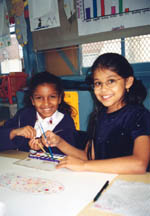|

Creative
Education Creates Miracles
by
Tom Kertes
In
most schools, wiggly, gyrating students are not looked upon too
kindly in class by their teachers. But in at least one program
in the city, the teacher actually leads the twisting. The Children’s
Movement for Creative Education (CMCE) is offering something new,
exciting and tantalizingly different every day in a number of
underfunded and reputedly uninterested New York City public elementary
schools.
This seven year-old non-profit organization is all about bringing
out the students’ creativity within the regular school curriculum.
Currently operating in PS 31, 152, 173, and 189 in New York City
under a contract with the Board of Education, Director Elana Haviv
and her colleagues have developed a child-centered approach that
brings subjects alive for children. “We try to redefine the role
of creative interaction and expression in education,” Haviv says.
Children might learn spelling through poetry, master geometry
through drawing, or interact with a real-life Holocaust survivor
to absorb history. “Our instructors and the classroom teachers
collaborate to revise the traditional curricula in order to offer
students new outlets of self-expression,” explains Haviv. “It
has been hard work, and a resounding success.”
CMCE instructors visit classrooms for an hour and a half each
week, staying with the same class for a period of two years. As
a result, over the past five years, CMCE students have indeed
demonstrated marked increases in academic achievement and motivation.
“The children and myself, we have both gained so much,” says Julie
Feinberg, a fifth-grade teacher at PS 31 in Brooklyn’s Greenpoint.
“These lessons have really inspired my students to love learning.”
Another teacher remarks, “This program goes both ways: it helps
the students become more creative and the results also show up
in the test scores.”
A visit to PS 31 reveals some of the reasons behind the success.
In the first CMCE class, the students followed up an earlier visit
to the Holocaust Museum with viewing a haunting film of photographs
about the Bosnian war. The lecturer for the day was Ron Haviv,
the photographer and noted Newsweek photographer (and CMCE’s director’s
brother).
“I
record history,” explains Mr. Haviv to the students. “My job is
to document things around the world that are going bad, so that
others around the world, like yourselves, could get aroused and
actually do something about it.”
The children, deeply drawn into the story of the concentration
camps and other horrors, immediately made the parallel between
the Holocaust and the Balkan war. “The main difference is that,
back then, people couldn’t know about what was going on as easily,”
sixth-grader Alex says. “There was no TV.”
Another child asks if Mr. Haviv was scared. “Well, over 60 journalists
were killed,” he answers in a low voice, simply bringing the point
home. “And, you know, some of that war is still going on today
in a place called Macedonia, even as we speak to each other today.”
At the same time, a fourth-grade class was creating inventions
after learning about Coney Island and the preceding Industrial
Revolution. “The crazier, the better,” exclaims instructor Philip
Courtney about the inventions. “Get those imaginations going,
please!”
How often does one see elementary school classes so excited, so
actively engaged? “One little boy, who rarely if ever speaks up,
just wouldn’t stop participating,” an amazed classroom teacher
relates after a class about nutrition from a chef. “I couldn’t
believe it. I think this pretty much says it all about what this
type of creative teaching can accomplish in discovering every
child’s potential to learn.” #
This
is the first story in a series of articles looking at organizations
such as CMCE that use art to teach academic skills in classrooms.
Education Update, Inc., P.O. Box 20005, New York, NY 10001. Tel:
(212) 481-5519. Fax: (212) 481-3919. Email: ednews1@aol.com.
All material is copyrighted and may not be printed without express consent of
the publisher. © 2001.
|

